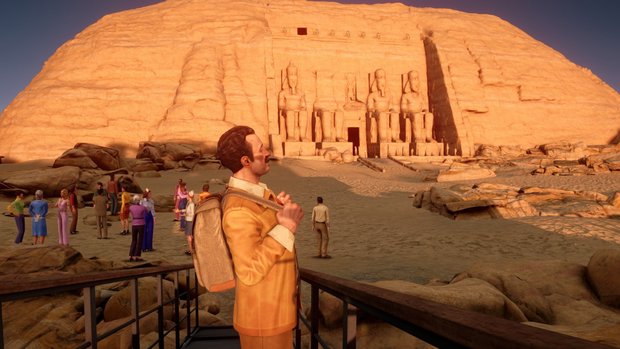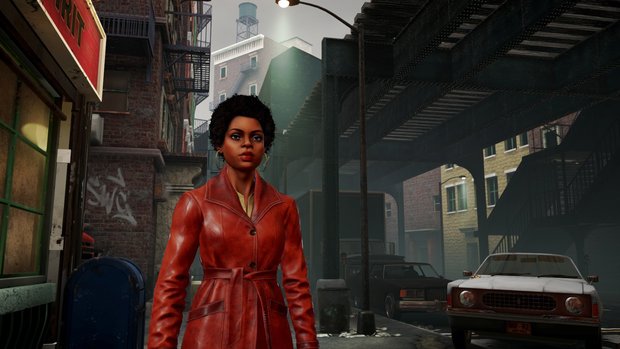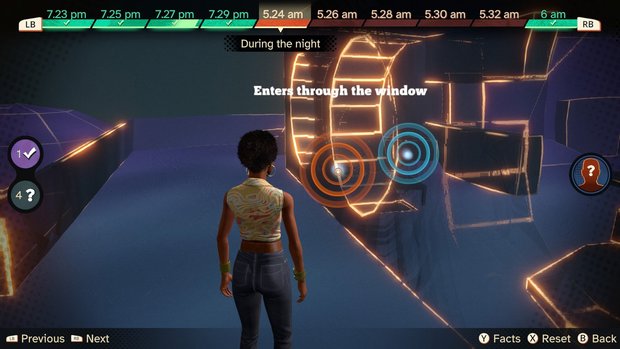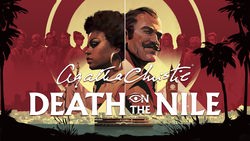Agatha Christie – Death on the Nile review

- 0 Comments
The flow can be unsteady, but Microids breathes impressive new life into a Queen of Crime classic.
As a gamer, there’s nothing more exhilarating than putting those little grey cells to use and sleuthing my way through a murder mystery, and Microids Studio Lyon has done it again with a new adaptation of a famous Agatha Christie novel. After Murder on the Orient Express, this time we play as both the world-renowned Hercule Poirot and his self-proclaimed biggest fan, Jane Royce, as we investigate a Death on the Nile. With similar yet improved production values and gameplay, this game has a much grander scale than when we were stuck on the train. The setting doesn’t have the same intimate charm as a result, and the expanded scope leads to some redundant quests that cause the focus to drift away from the actual murder investigation at times. However, the logic puzzles are a joy to solve and making the right deductions always gets you a rewarding pat on the back from the moustachioed master himself.
While the previous game took Poirot all the way into the 21st century, this adaptation lands us smack dab in the middle of the 1970s. Disco! Floral-patterned shirts! No cell phones! The great Belgian detective has the same dashing design, though Geoffrey Bateman takes over from Leslie Clack as his voice actor. I must admit I was a bit disappointed that the character didn’t quite sound the same, but I quickly got used to his slightly different timbre and accent. The rest of the voice cast charms their way into your heart as well with one particular accent or other, the crisp, intriguing writing giving each their own little backstory to uncover.
As was the case with Orient Express, an original new character was created to add another layer to a story that many people are familiar with. British P.I. Jane Royce takes the female lead this time. While she tries to copy Poirot’s methods as best she can – and she can truly compete with him! – she’s also a woman of action. “Poirot doesn’t run,” the man always says, so when it’s time for a good old-fashioned chase, it’s Jane who must go the extra mile. She is voiced by Chloe Dunn, who does a good job of portraying a bold and confident young black woman in the 1970s.

The story starts with a prologue in a London discotheque in 1974. Serving as a tutorial to teach you the ropes, it’s similar to the intro in the last game except this time the mystery connects better to the main story. Here wealthy heiress Linnet Ridgeway is being proposed to by a suitor, but the ring has vanished and it’s up to you, as Poirot, to figure out what happened to it. It’s here that Poirot and Jane first meet before separating to follow their own goals: Poirot joins a travel group to visit Egypt, while Jane goes off in pursuit of an assassin nicknamed “The Spider,” whom she holds responsible for the death of a dear friend. Playing as Jane, you also have to make some choices that define which of the two available epilogues you get.
You control both protagonists in a third-person perspective, either by gamepad or keyboard/mouse combo, exploring your surroundings and looking for clues. The scenery is once again sublime and very immersive, with organic shapes and sinuous curves so distinctive of 70s-era furniture and decor, like the typical egg chair and the orange and brown flower patterns on the wallpaper and carpeting. Once the matter of the ring is resolved, from London you’ll travel to such (mostly) exotic locales as the Imperial Nile Hotel in Aswan, a vacation resort on Majorca, the Karnak paddle wheeler river boat, the dark and dilapidated alleys of the Bronx in New York, the mysterious ancient Egyptian temple Abu Simbel, and Cairo with its thousand market stalls.
The graphical quality has improved since Orient Express, which was already very good. The 3D environments aren’t yet at the same realistic level of, say, a Life Is Strange game, though they do appear smoother. There’s still something graphic-novelly about the character designs, but they now show more detailed textures. And while they tend to move rather woodenly with hardly any use of facial muscles, their outfits and hairstyles totally fit the retro 70s ambience. Accompanying the wonderful sights is some groovy, funky but also thrilling and mysterious music all composed by Abigoba. Violins, saxophones and electric guitars took turns sweeping me off my feet as the soundtrack’s rhythm matched the on-screen events so effectively that I felt like I was really there.

Purely by chance, Poirot eventually winds up on the same cruise ship as some familiar faces from the prologue. While you will have to solve other mysteries along the way – some seemingly minor, some significant – the actual murder in Death on the Nile doesn’t occur until chapter 7 (of 11), which seemed a bit too far along. Thankfully it’s worth the wait, as it’s the most interesting mystery in the bunch and really had me guessing at the truth until the end. I had to try three times, attempting to fit the facts with two other possible killers, before finally seeing the light and realizing the true grand scheme behind the murder.
There’s a LOT to do before getting to that point, mind you. My personal strategy at each new location was to first investigate all rooms. Interesting hotspots, be they clues, red herrings or decorative items catching Poirot’s attention, are indicated by an orange circle. Once examined, a green tick is added to the circle to make it clear you’ve done all you can with it. Then I talked to the other characters available, often with many people to question, such as Linnet and her husband Simon, their personal assistant Louise, accountant Andrew, Dr. Bessner, old Lady Van Schuyler and her nurse Miss Bowers, the Lady’s niece Cornelia, mother and daughter Otterbourne, and several more, including the staff on board the cruise ship. You can only ask them about each dialogue topic once, except for the “small talk” option, so you better pay attention! And return when new information arises, since extra dialogue options are added as you discover things.

Sometimes you will have the chance to eavesdrop on conversations. Indicated by an ear icon, you can activate eavesdropping and the quality of the voices is shown as a flowing sound wave. You will have to move into the best position to hear them perfectly without them noticing you, which often takes a couple of tries. But no worries if you’re spotted, since there’s nothing to stop you from trying over and over again until you’ve succeeded.
Exploration and interrogation are only half the task of a detective. The second part is going over all the facts and putting everything together. Death on the Nile still employs an intuitive mind map system to process clues and suspects, and it has been improved upon since Orient Express. The board now lets you know when a connection between clues can be made, and the following deduction either unlocks new dialogue or can be connected to yet another clue. This part of the puzzling is pretty straightforward and sometimes the solution is so apparent, if I could I would have just skipped these steps because the outcomes are so obvious. But Poirot doesn’t do anything half-baked, and he wants to be absolutely sure he’s got all his eggs in his basket.
While some facts are noted down on the deduction board, the game expects you to remember lots of details yourself – at least in the hardest gameplay mode. There are three difficulty levels. The prologue starts in “Story” mode, constantly directing you where to go and what to do. At the start of the first real chapter you can choose how to continue, but you can switch difficulty levels whenever you want. “Herculean” mode is the hardest, doing away with all help and leaving you to figure things out completely on your own. “Detective” mode is the normal setting, less guided than Story but still giving some pointers here and there. Since I found Murder on the Orient Express quite easy. I decided to really challenge myself and play Death on the Nile at the hardest setting, which took me a whopping twenty-three and a half hours to complete! I’m sure most players will get through Detective and Story modes faster than that, though.
The game is filled with little puzzles and mini-games, usually involving some device or other in need of repair. These will give you a particular clue, requiring you to move components and put the equipment’s settings in the right order. You can also get people talking if you help them out, such as by fixing a jukebox and playing someone’s favorite song, or by winning at card or Mahjong games in a gambling den. There are also more straightforward puzzles, like having to figure out a code for a locked briefcase. My personal favorite was using Jane’s lockpicks, with which you have to trip the tumblers in the correct order. As fun as all these “puzzle boxes” can be, they happen so often that they sometimes seem like overkill. I preferred playing at being a detective, searching for clues, questioning suspects and deducing the truth. Too often it felt like a generic adventure game with some kind of mechanical puzzle thrown in to make the experience more difficult. Some are quite tricky and it’s easy to question whether they really fit into this game.

That’s perhaps my biggest complaint about Death on the Nile. It’s eleven chapters long, including the prologue and a very unexpected epilogue, and some of them feel very much embellished with sequences that just seem to be there to prolong the play time. Granted, they introduce new gameplay elements, but even though they are quite well integrated into the storyline, they sometimes felt more like chores to me. For example, Poirot’s primary reason for traveling to Egypt is to solve the ancient mystery behind the Abu Simbel temple. But half of that chapter has you playing with mirrors and magnifying glasses in trial-and-error fashion to concentrate and reflect sunlight around corners, as if you were not a detective but a world-famous archeologist instead. And before that is even possible, you have to take over steering the ship across the Nile, being careful not to hit any sandbanks.
In another chapter, playing as Jane Royce, you walk through the many mazelike alleyways of Cairo, first to find a particular café, then to stealthily follow some bad guys, and then to find your way inside their hideout – and back out, of course. Later on, still playing as Jane, there’s a part in the story where you have to escape captivity. This involves some inventory puzzles, except you don’t have an inventory in this game. Instead, the items are strewn about like other pieces of evidence, and to combine them you have to examine them, which adds them to her own mind map, then link them together on its deduction board as if you were making a connection. If correctly combined, Jane then performs the task you designed. While a nice new take on this style of gameplay, it feels a bit out of place and an overly elaborate way to solve a puzzle.
Alternating between Hercule Poirot and Jane Royce is fun, though. Eventually the paths of these two main characters converge again, and then you can actively alternate between Jane searching for evidence and Poirot questioning the witnesses about what she has found. I thought this was the most entertaining and truly Poirot part of the game, where you’re finally starting to investigate the actual murder. During this chapter, Jane and Poirot actually share the same mind map, so you can make your deductions with either character.

The real challenge of Death on the Nile is fitting all of its characters into a correct chronology. During certain sequences, the real environments are exchanged for a kind of shadow version without any textures or other details, implying that we are still inside Poirot’s mind. You can walk around a bare purplish-blue layout of the rooms, even through walls, while important elements are shown in a golden frame. Your task is to position your suspects/witnesses at several points in time according to the information they have given you. To make everything fit you need to compare everyone’s statements, and eventually you'll always discover a lie. Then you must confront that person, point out the discrepancy in their statement and choose the correct piece of evidence that refutes it. To take the example of the prologue chapter, you will have to correctly position everyone in the disco to see which person was capable of sneaking into position to secretly take the ring. Later on you will face similar puzzles to discover who tried to tamper with Linnet Ridgeway’s dinner on board the Nile cruise ship, and who caused a statue to almost drop down on an unsuspecting victim from the temple ledge above.
Hidden among the important pieces of evidence are optional golden moustaches (100 throughout the entire game!) as well as 16 golden vinyl records, one for each musical track. Sometimes you need to solve a logic puzzle to unlock a moustache, like turning the number plates of a clock in their proper position or ringing a ship’s bell in the right rhythm. From the game’s main menu, you can access a “Museum,” where you can walk around as Poirot or Jane (your choice) between blank screens and empty pedestals, unlocking game artwork and statues of the characters relative to the number of moustaches you found. There’s a jukebox at the entrance, where you can play all the vinyls you’ve discovered. The (presumably) greatest treasure is hidden by enormous double doors at the back, which only open once you have found all collectibles. Sadly, I wasn’t enough of a master sleuth to be allowed a peek.
Character profiles are another type of collectible. For each important character, you’re tasked with filling in the blanks in The Case of the Golden Idol fashion: first and last name, profession, any links to other characters, and their secret. All but the last answer can usually be found pretty fast, though the professions can sometimes remain elusive for a while too. Thankfully you can access complete transcripts of every conversation with these people, which should hold at least most of the necessary clues to figuring it all out. Completing these profiles isn’t necessary for the story, though of course discovering some secrets do matter in the big picture.
The game has an autosave function but also allows up to ten manual save files. You can restart each chapter from the main menu, which is a great way to revisit areas in case you missed some collectibles. During Jane’s stealth sections, you can be discovered if you make a wrong move, but you are given unlimited tries to get it right. Same with deductions in the mind map: make a wrong connection and the screen will glow red instead of green, immediately giving you another chance. It’s possible to brute-force your way through Death on the Nile, but here each chapter ends with an overview of not only how many collectibles you found, but also how many mistakes you made, and even the number of steps you took.
Final Verdict
I’m terribly ashamed to admit it, but I’ve never read the original Death on the Nile novel. I will get around to it someday, but in the meantime I was very happy to play through this interactive and embellished version of the story. For those who have read it or seen the various movie adaptations, the addition of Jane should add some much-needed novelty, and the two storylines of Jane and Poirot intertwine masterfully and even lead to an epilogue I didn’t see coming but made perfect sense. There seems to be a lot more to do here than on the Orient Express – perhaps even a bit too much that doesn’t really seem relevant to the story. And yet I was captivated by the setting and scenery, and really liked searching around for clues and elusive collectibles, as well as questioning people and trying to figure out their secrets. I’m very much a fan of these Poirot games, so I hope that if there’s another, Microids remembers that solving a murder with one of literary fiction’s greatest detectives is interesting enough without a boatful of diversions.
Hot take
The expanded world of Agatha Christie – Death on the Nile might feel a bit TOO big at times, but the new playable character does add to the story and nothing gives a greater sense of accomplishment than solving a mystery as Hercule Poirot.
Pros
- Authentic 70s look with a lively musical soundtrack
- Great variety of puzzles
- Challenging mental reconstruction of events
- Masterful blending of the familiar murder mystery and Jane Royce’s original new story
Cons
- Solving puzzle boxes and smaller mysteries tends to dominate the actual murder investigation
- Character animations appear a bit wooden
Johnny played Agatha Christie – Death on the Nile on PC using a review code provided by the game’s publisher.











0 Comments
Want to join the discussion? Leave a comment as guest, sign in or register.
Leave a comment